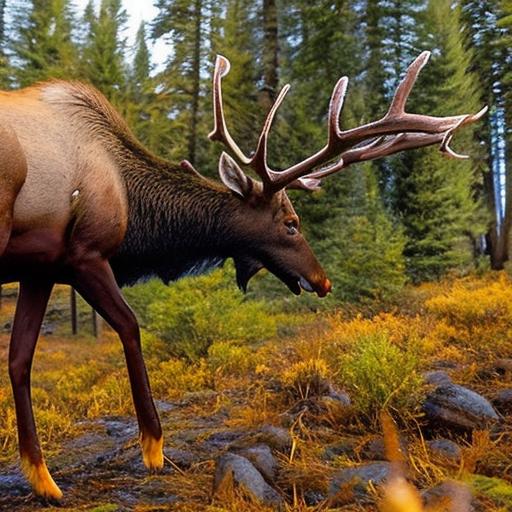Your cart is currently empty!

Unleashing the Thrill of Roosevelt Elk Hunting in Oregon: A Guide to the Ultimate Adventure

Roosevelt Elk hunting in Oregon is an exhilarating and rewarding experience that allows hunters to immerse themselves in the beauty of the Pacific Northwest. As an avid hunter myself, I have had the privilege of embarking on several Roosevelt Elk hunting trips in Oregon, and each one has been a unique and unforgettable adventure. In this article, I will share my personal experiences and provide valuable insights into understanding the Roosevelt Elk, planning your hunting trip, essential gear and equipment, tracking and scouting techniques, choosing the right weapon, safety precautions, field dressing and processing, cooking and enjoying your harvest, as well as the importance of conservation and sustainability in hunting.
Key Takeaways
- Roosevelt Elk hunting in Oregon is a majestic experience that requires planning and preparation.
- Understanding the habitat, behaviors, and characteristics of Roosevelt Elk is crucial for a successful hunt.
- Planning your trip according to the season, location, and permits is essential for a legal and safe hunt.
- Essential gear and equipment, tracking and scouting techniques, and choosing the right weapon are all important factors for a successful hunt.
- Safety precautions, field dressing and processing tips, and conservation and sustainability practices are crucial for responsible Roosevelt Elk hunting in Oregon.
Understanding the Roosevelt Elk: Habitat, Behaviors, and Characteristics
The Roosevelt Elk, also known as the Olympic Elk, is one of the largest species of elk in North America. They are native to the Pacific Northwest region of the United States, with a significant population found in Oregon. These majestic creatures can weigh up to 1,000 pounds and have impressive antlers that can span up to six feet in length.
Roosevelt Elk are primarily found in dense forests and coastal regions, where they have access to ample food sources such as grasses, shrubs, and tree bark. They are highly adaptable animals and can thrive in a variety of habitats, including old-growth forests, clearcuts, and even agricultural fields.
In terms of behavior, Roosevelt Elk are known for their elusive nature and keen senses. They have excellent hearing and sense of smell, which makes them incredibly difficult to approach undetected. They are also highly social animals and live in herds consisting of cows (females) and calves, with bulls (males) forming separate bachelor groups outside of the breeding season.
Planning Your Roosevelt Elk Hunting Trip: Season, Location, and Permits
When planning your Roosevelt Elk hunting trip in Oregon, it is essential to consider the best season, location, and permits required for a successful hunt.
The best season for Roosevelt Elk hunting in Oregon is typically during the fall, specifically September through November. This is when the elk are in their rutting season, which means the bulls are actively seeking out cows for mating. During this time, the bulls are more vocal and can be easier to locate.
When it comes to choosing the ideal location for your hunt, Oregon offers a variety of options. The coastal regions of Oregon, such as the Tillamook State Forest and Siuslaw National Forest, are known for their dense elk populations. The Cascade Mountains and the Wallowa Mountains also provide excellent hunting opportunities. It is important to research and scout potential hunting areas beforehand to ensure you are familiar with the terrain and elk patterns.
In order to hunt Roosevelt Elk in Oregon, you will need to obtain the necessary permits and licenses. The Oregon Department of Fish and Wildlife (ODFW) offers both general season tags and controlled hunt tags for elk hunting. It is important to check the ODFW website for specific regulations and requirements before applying for tags.
Essential Gear and Equipment for a Successful Roosevelt Elk Hunt
| Essential Gear and Equipment for a Successful Roosevelt Elk Hunt |
|---|
| Rifle or Bow |
| Ammunition or Arrows |
| Binoculars |
| Spotting Scope |
| Clothing Layers |
| Boots |
| Backpack |
| Water Bottle or Hydration System |
| Food and Snacks |
| Map and Compass or GPS |
| Knife |
| Game Bags |
| Rope or Paracord |
| First Aid Kit |
| Headlamp or Flashlight |
| Fire Starter |
Having the right gear and equipment is crucial for a successful Roosevelt Elk hunt in Oregon. Here are some essential items you should consider:
Clothing and footwear: Dressing appropriately for the weather conditions is essential. Layered clothing is recommended, as temperatures can vary throughout the day. Waterproof and insulated boots are also a must, as you may encounter wet and muddy terrain.
Hunting gear: A quality rifle or bow is necessary for taking down a Roosevelt Elk. Make sure your weapon is properly sighted in and that you are proficient in using it. Optics such as binoculars or a spotting scope can also be helpful for scouting and locating elk.
Camping gear: If you plan on camping during your hunting trip, you will need a sturdy tent, sleeping bag, and camping stove. It is important to pack lightweight and compact gear that is easy to carry.
Tracking and Scouting Techniques for Roosevelt Elk Hunting in Oregon
Tracking and scouting are essential skills for successful Roosevelt Elk hunting in Oregon. Here are some tips to help you in your pursuit:
Tracking: Look for fresh elk sign such as tracks, droppings, and rubs. Pay attention to the direction of travel and the freshness of the sign. Elk tend to follow well-defined trails, so look for these paths and follow them to increase your chances of encountering elk.
Scouting: Before your hunt, spend time scouting the area you plan to hunt. Look for areas with fresh sign, such as feeding areas and wallows. Use binoculars or a spotting scope to glass open areas and meadows where elk may be feeding or bedding down.
Understanding behavior: Familiarize yourself with the behavior of Roosevelt Elk. Learn their vocalizations, such as bugling, which is often heard during the rutting season. Understanding their behavior can help you anticipate their movements and increase your chances of a successful hunt.
Choosing the Right Weapon for Roosevelt Elk Hunting: Rifle, Bow, or Muzzleloader

When it comes to choosing the right weapon for Roosevelt Elk hunting in Oregon, there are several factors to consider. Here are some pros and cons of using a rifle, bow, or muzzleloader:
Rifle: Using a rifle provides hunters with long-range accuracy and stopping power. This can be advantageous when hunting in open areas or when taking longer shots. However, rifles can be heavy and cumbersome to carry in rugged terrain.
Bow: Hunting with a bow requires a higher level of skill and patience. Bowhunting allows for a more intimate hunting experience, as it requires getting closer to the elk. It also provides a greater challenge and can be incredibly rewarding. However, bowhunting requires more practice and proficiency to ensure clean and ethical kills.
Muzzleloader: Hunting with a muzzleloader is a traditional and challenging method. Muzzleloaders have a slower rate of fire and require careful reloading after each shot. This can make it more difficult to take follow-up shots if needed. However, hunting with a muzzleloader can provide a unique and nostalgic hunting experience.
Safety Precautions and Best Practices for Roosevelt Elk Hunting in Oregon
Safety should always be a top priority when engaging in Roosevelt Elk hunting in Oregon. Here are some safety precautions and best practices to keep in mind:
– Always let someone know your hunting plans, including your expected return time and the location you will be hunting.
– Familiarize yourself with the area you will be hunting and carry a map, compass, or GPS device.
– Practice proper firearm safety at all times. Treat every firearm as if it is loaded and never point it at anything you do not intend to shoot.
– Wear blaze orange or other highly visible clothing to ensure you are easily seen by other hunters.
– Be aware of your surroundings and watch for other hunters in the area.
– Carry a first aid kit and know basic first aid procedures.
– Stay hydrated and take breaks when needed to avoid exhaustion or dehydration.
Field Dressing and Processing Your Roosevelt Elk: Tips and Tricks
Field dressing and processing your Roosevelt Elk properly is essential to ensure the quality of the meat. Here are some tips and tricks for field dressing:
Step-by-step guide to field dressing: Start by making an incision from the base of the sternum to the pelvic bone. Carefully remove the internal organs, being cautious not to puncture the intestines or bladder. Remove the heart, liver, and kidneys for inspection. Rinse the cavity with cold water to remove any blood or debris. Finally, prop the chest cavity open to allow air circulation and cool the meat.
Tips for processing and preserving the meat: After field dressing, it is important to cool the meat as quickly as possible. If possible, hang the carcass in a cool, shaded area to allow air circulation. If you are unable to hang the carcass, quarter it and place it in game bags or coolers with ice. It is also important to remove any excess fat or silver skin from the meat to prevent spoilage.
Proper disposal of waste materials: When field dressing your Roosevelt Elk, it is important to properly dispose of waste materials. Burying the entrails and other waste in a deep hole away from water sources is a common practice. Alternatively, you can pack out the waste materials in a trash bag and dispose of them properly at a designated waste facility.
Cooking and Enjoying Your Roosevelt Elk Harvest: Delicious Recipes and Ideas
Cooking and enjoying your Roosevelt Elk harvest is one of the most rewarding aspects of hunting. Here are some delicious recipes and ideas for preparing your elk meat:
Recipes for cooking Roosevelt Elk meat: Some popular recipes for cooking elk meat include elk steaks, elk burgers, elk chili, and elk stew. Elk meat is lean and flavorful, making it a versatile ingredient for a variety of dishes.
Tips for preparing and cooking the meat: When preparing elk meat, it is important to marinate it beforehand to enhance its tenderness and flavor. Elk meat should be cooked to medium-rare or medium to prevent it from becoming tough and dry. Avoid overcooking the meat, as this can result in a less enjoyable eating experience.
Ideas for enjoying your Roosevelt Elk harvest: Host a wild game dinner party and invite friends and family to enjoy your harvest. Share your hunting stories and recipes with others who appreciate the beauty of hunting and sustainable food sourcing. Consider donating some of your elk meat to local food banks or charitable organizations to give back to the community.
Conservation and Sustainability of Roosevelt Elk Hunting in Oregon: A Responsible Hunter’s Guide
Conservation and sustainability are crucial aspects of responsible hunting. Here are some tips for practicing conservation and sustainability while Roosevelt Elk hunting in Oregon:
Importance of conservation and sustainability in hunting: Hunting plays a vital role in wildlife management and conservation efforts. By participating in responsible hunting practices, hunters contribute to the preservation of wildlife populations and their habitats.
Tips for responsible hunting practices: Practice selective harvesting by targeting mature bulls and leaving younger animals to ensure healthy population growth. Respect private property and obtain permission from landowners before hunting on their land. Follow all hunting regulations and report any illegal activities or violations you witness.
Ways to give back to the environment and community through hunting: Consider volunteering for wildlife conservation organizations or participating in habitat restoration projects. Share your knowledge and experiences with others, especially younger generations, to promote a deeper understanding and appreciation for hunting and conservation.
In conclusion, Roosevelt Elk hunting in Oregon offers hunters a unique opportunity to connect with nature, challenge themselves, and provide sustenance through sustainable means. By understanding the habitat, behaviors, and characteristics of Roosevelt Elk, planning your trip carefully, using the right gear and equipment, practicing tracking and scouting techniques, choosing the right weapon, prioritizing safety, properly field dressing and processing the meat, cooking and enjoying your harvest, as well as embracing conservation and sustainability practices, you can have a truly memorable and fulfilling hunting experience.
If you’re interested in Roosevelt elk hunting in Oregon, you might also enjoy reading about “How to Hunt Pheasant” on Old Oak Syndicate’s website. Pheasant hunting can be an exciting and challenging experience, and this article provides valuable tips and techniques for a successful hunt. Whether you’re a seasoned hunter or a beginner looking to try something new, this article will provide you with the knowledge and strategies needed to pursue pheasants in the wild. Check it out here.
FAQs
What is a Roosevelt elk?
Roosevelt elk is a subspecies of elk that is native to the Pacific Northwest region of North America. They are the largest of the four subspecies of elk found in North America.
Where can I find Roosevelt elk in Oregon?
Roosevelt elk can be found in various parts of Oregon, including the Coast Range, Cascade Mountains, and the southern part of the state.
When is the hunting season for Roosevelt elk in Oregon?
The hunting season for Roosevelt elk in Oregon varies depending on the location and the type of hunting. Generally, the season runs from August to November.
What are the hunting regulations for Roosevelt elk in Oregon?
The hunting regulations for Roosevelt elk in Oregon are set by the Oregon Department of Fish and Wildlife. Hunters are required to have a valid hunting license and tag, and there are restrictions on the type of weapons and ammunition that can be used.
What is the success rate for Roosevelt elk hunting in Oregon?
The success rate for Roosevelt elk hunting in Oregon varies depending on the location and the hunting method. Generally, the success rate is around 20-30%.
What is the cost of a Roosevelt elk hunting trip in Oregon?
The cost of a Roosevelt elk hunting trip in Oregon varies depending on the outfitter and the type of hunting. Generally, the cost can range from $5,000 to $10,000 or more.

Herb has been a longtime lover of the outdoors. Whether it be hunting, camping, fishing or just getting outside to reset. Proud father and animal lover. Bourbon anyone?

by
Tags:
Comments

Categories
- Big Game Hunting (301)
- Deer (202)
- Reviews (3)
- Shooting (16)
- Slingshot (1)
- Small Game Hunting (42)
- Upland Hunting (126)
- Waterfowl Hunting (3)





Leave a Reply